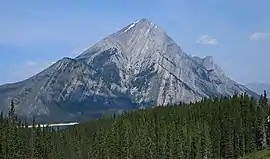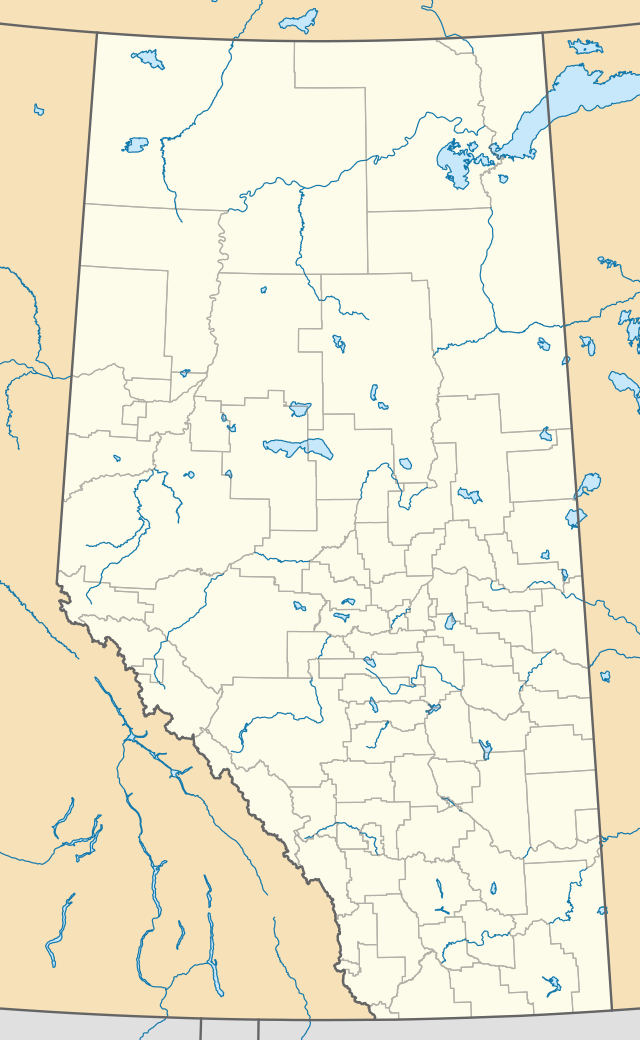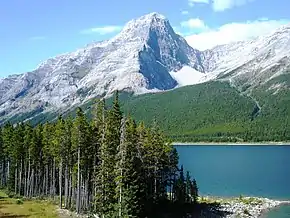Mount Nestor (Alberta)
Mount Nestor is a 2,970-metre (9,740 ft) mountain summit located in Kananaskis Country in the Canadian Rockies of Alberta, Canada. It is named after HMS Nestor, a destroyer sunk in the Battle of Jutland during World War I.[1] Mount Nestor is situated at the south end of the Goat Range along the west shore of Spray Lakes Reservoir. Nestor's east flank is within Spray Valley Provincial Park, while the west aspect is within Banff National Park, with the boundary line between the two parks running roughly north-to-south over its summit. The nearest higher peak is Old Goat Mountain, 2.0 km (1.2 mi) to the north.[1] Mount Nestor can be seen from Alberta Highway 742, the Smith-Dorrien/Spray Trail.
| Mount Nestor | |
|---|---|
 Mount Nestor seen from the south | |
| Highest point | |
| Elevation | 2,970 m (9,740 ft) [1] |
| Prominence | 288 m (945 ft) [1] |
| Parent peak | Old Goat Mountain (3120 m)[1] |
| Listing | Mountains of Alberta |
| Coordinates | 50°55′41″N 115°21′53″W [2] |
| Geography | |
 Mount Nestor Location of Mount Nestor in Alberta  Mount Nestor Mount Nestor (Canada) | |
| Location | Alberta, Canada |
| Parent range | Canadian Rockies |
| Topo map | NTS 82J/14[2] |
| Geology | |
| Age of rock | Cambrian |
| Type of rock | sedimentary rock |
| Climbing | |
| First ascent | 1913 by Interprovincial Boundary Commission |
| Easiest route | Scrambling South Ridge[3] |

History
The first ascent of the mountain was made in 1913 by the Interprovincial Boundary Commission.[4] The mountain's name was officially adopted in 1922 by the Geographical Names Board of Canada.[2]
Geology
Mount Nestor is composed of sedimentary rock laid down during the Precambrian to Jurassic periods.[5] Formed in shallow seas, this sedimentary rock was pushed east and over the top of younger rock during the Laramide orogeny.[6]
Climate
Based on the Köppen climate classification,Mount Nestor is located in a subarctic climate with cold, snowy winters, and mild summers.[7] Temperatures can drop below −20 °C (−4 °F) with wind chill factors below −30 °C (−22 °F). Precipitation runoff from the mountain drains into the Spray Lakes Reservoir.
See also
References
- "Mount Nestor". Bivouac.com. Retrieved 2018-11-15.
- "Mount Nestor". Geographical Names Data Base. Natural Resources Canada. Retrieved 2018-11-15.
- Kane, Alan (1999). "Mount Nestor". Scrambles in the Canadian Rockies. Calgary: Rocky Mountain Books. pp. 91–92. ISBN 0-921102-67-4.
- "Mount Nestor". PeakFinder.com. Retrieved 2019-06-25.
- Belyea, Helen R. (1960). The Story of the Mountains in Banff National Park (PDF). parkscanadahistory.com (Report). Ottawa: Geological Survey of Canada. Archived (PDF) from the original on 2015-10-02. Retrieved 2019-09-13.
- Gadd, Ben (2008). Geology of the Rocky Mountains and Columbias.
- Peel, M. C.; Finlayson, B. L.; McMahon, T. A. (2007). "Updated world map of the Köppen−Geiger climate classification". Hydrol. Earth Syst. Sci. 11: 1633–1644. ISSN 1027-5606.
External links
 Media related to Mount Nestor (Alberta) at Wikimedia Commons
Media related to Mount Nestor (Alberta) at Wikimedia Commons- Weather forecast for Mount Nestor Mountain Forecast
- Spray Valley Provincial Park Alberta Parks
- Banff National Park National Park Service